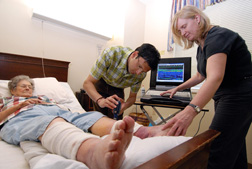For people with impaired mobility and reduced ability to sense injury, the risk is high for pressure ulcers that can develop when they sit or recline in one position too long or wear a poorly-fitted prostheses for an extended period.
 |
|
Clinical data collection helps drive the researchers’ modeling and algorithm development. Though these studies don’t reveal the etiology and the time base on bruises, they will provide enough background information to do controlled animal studies later. Georgia Tech Photo: Gary Meek |
Health care professionals routinely check patients for early signs of erythema, or skin redness. But visual inspections sometimes fail to detect reddening of the skin and other indicators of tissue damage, especially in people with darkly pigmented skin. If undetected, these at-risk sites can develop pressure ulcers.
…
Add new comment